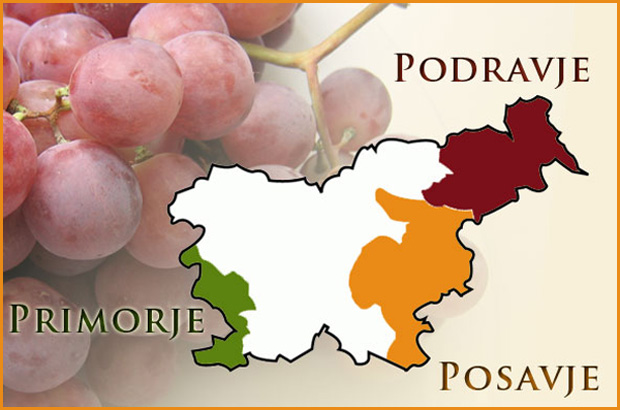Wine Regions of Slovenia
Wine Guide 2022
Situated in the southwestern corner of the country along the Italian border and the Adriatic Sea, Primorje’s name is taken from the Slovene phrase “by the sea.” It is blessed with a typical Mediterranean climate, with an early spring, warm, sunny summers, a short rainy season in September and October, and dry winds coming off the sea in the fall and winter. This has the effect of making the grapes ripen quickly, with low acidity, high sugar content, and strong pigments. Wines from Primorje are generally dry and rich in minerals, with reds and whites each making up about half of the region’s production.
There are four sub-regions within Primorje, each with its own subtle differences in climate and soil. BRDA, in the northernmost portion of Primorje, features low rocky hills with terraced vineyards and somewhat higher rainfall than other areas of the region. The VIPAVA VALLEY is a lush green expanse, with rich soils and moderate rainfall, that straddles the Vipava River on its way to the Adriatic. KRAS is a relatively flat area known for its red limestone soil, high in aluminum and iron oxides, and its hot, dry summers. KOPER, the area around Slovenia’s port city of the same name, has vineyards planted on plateaus overlooking the sea, exposed to the strong Mediterranean sun but protected by the higher humidity of the sea air.
The Posavje region rests along the Croatian border in the southeastern portion of Slovenia. Posavje has a long tradition of small, independent wine producers, and each has their own ideas about how to produce the best wines from the region’s varied soils and growing conditions. Among the hills of Posavje there are a great number of distinct soil types, some of which are highly localized. The climate is equally wide-ranging, with some of the wettest and driest conditions of the Slovene winegrowing regions separated by very short distances. Though more white wines are produced overall in Posavje, many reds are bottled as well, and in some areas reds actually predominate.
Four sub-regions make up Posavje: from south to north, they are SMARJE-VIRSTAJN, BIZELJSKO-SREMIC, DOLENSKA, and BELA KRAJINA. SMARJE-VIRSTAJN rests in the shadow of the Alps, with a cool climate and sandstone soils necessitating careful placement of the vineyards among the rolling wooded hills. BIZELJSKO-SREMIC is a narrow strip along the northern bank of the Sava River, protected by the mountains from the harsh north winds and home to perhaps the best wine growing conditions in the region. Across the Sava and further south is DOLENSKA, which makes up most of the Posavje region, an area with both alpine and Pannonian climatic influences, gentle hills, and south-facing vineyards. Where the foothills of the Alps give way to the more open plains is the area called BELA KRAJINA, known for hot summers, cold, snowy winters, and the rocky limestone soil known as karst.
Tucked into the northeastern corner of Slovenia, bordering Austria, Hungary, and Croatia, is Podravje, the largest of Slovenia’s wine-growing regions. The area was once part of an ancient sea floor, and the resulting soils are full of nutrients and minerals that make them ideal for cultivating wine grapes. The climate is typically continental, with some influence from the Alps on the western portions of the region. Summers are very hot and sometimes dry, with winters being tempered somewhat by the shield of the mountains to the north and west. Aromatic white wines predominate the region’s production, though reds have been growing in popularity with some of the local producers in recent years. The area is particularly known for late-harvest and other select quality wines.
Podravje is divided into six smaller wine-growing areas: MARIBOR, the westernmost, RADGONA-KAPELA, SREDNJE SLOVENSKE GORICE, HALOZE, LJUTOMER-ORMOZ, and PREKMURSKE GORICE on the eastern tip. MARIBOR is home to two historical artifacts of Slovene viticultural tradition: the oldest continuously-producing vine in Europe, four hundred and forty years old, and the vineyards started by Hapsburg Archduke Johann in 1822. Vines planted in MARIBOR’s quartz-rich marl and clay foothills generally face east, and produce some of Slovenia’s best Rizlings. The hilltop vineyards of RADGONA-KAPELA are particularly suited to late harvest and ice wines. SREDNJE SLOVENSKE GORICE is home to the oldest wine archive in Slovenia, which houses pre-war vintages of some of the fine whites for which the area is known. The thin strip of land that forms the HALOZE area is bounded by the Drava River on the north and the Alps to the south and west, with vineyards planted along the steep hillsides. LJUTOMER-ORMOZ is a small area of low, fertile hills and a moderate climate that produces some fine white wines. PREKMURSKE GORICE is a large, generally flat area that grows much of Slovenia’s grain as well as wine grapes, with hot, dry summers that promote the production of dry white wines.



